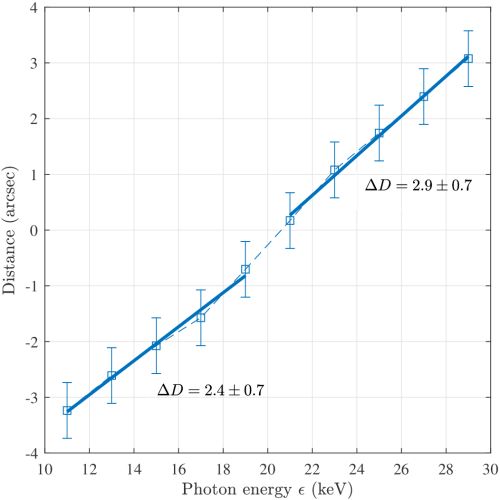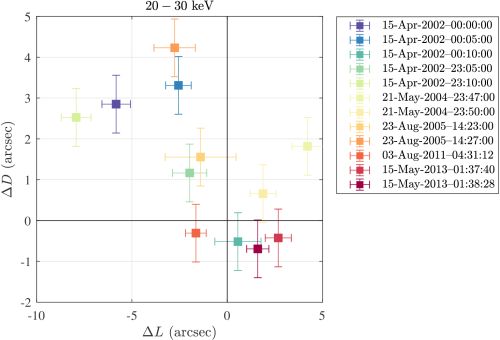Coronal Hard X-ray Sources Revisited
| Nugget | |
|---|---|
| Number: | 333 |
| 1st Author: | Brian Dennis |
| 2nd Author: | |
| Published: | 24 September 2018 |
| Next Nugget: | White-light Emission and Non-thermal Electrons |
| Previous Nugget: | Photospheric response to a flare |
Introduction
For the most part RHESSI observes hard X-rays (HXRs) from bright footpoint sources via the Neupert Effect. These footpoint sources lie at the intersections of coronal magnetic fields with the lower solar atmosphere. As many of these Nuggets have discussed, RHESSI also sees a variety of sources in the solar corona.
A recent paper (Ref. [1]) attempts to set the record straight by reinterpreting observations of a group of flares that have been reported to have hard X-rays (HXRs) coming predominantly from the corona rather than from the more usual chromospheric footpoints (Ref. [2,3,4,5,6]). All of the 26 previously analyzed event time intervals, over 13 flares, were re-examined for consistency with a model in which electrons are accelerated near the top of a magnetic loop that has a sufficiently high density to stop most of the electrons by Coulomb collisions before they can reach the footpoints. Of particular importance in the previous analysis was the finding that the length of the coronal HXR source increased with energy in the 20 - 30 keV range. Such behavior is inconsistent with a unique thermal source in equilibrium, the size of which must generally decrease with increasing energy as the emission becomes more and more dominated by the hottest regions. The observed behavior would however be consistent with the transport of accelerated electrons through a collisional target, since higher energy electrons travel further.
However, after allowing for the possibility that footpoint emission at the higher energies affects the inferred length of the coronal HXR source, and using analysis techniques that suppress the possible influence of such footpoint emission, we conclude that there is no longer evidence that the length of the HXR coronal sources increase with increasing energy. In fact, for the 6 flares and 12 time intervals that satisfied our selection criteria, the loop lengths decreased on average by 1.0 ± 0.2 arcsec between 20 and 30 keV, with a standard deviation of 3.5 arcsec. We also find strong evidence that the peak of the coronal HXR source increases in altitude with increasing energy. For the thermal component of the emission, this is consistent with the standard ("CHSKP") flare model in which magnetic reconnection in a coronal current sheet results in new hot loops being formed at progressively higher altitudes. The explanation for the nonthermal emission remains unclear.
Example Flare - 14/15 April 2002
The effect of weak footpoint emission at higher energies on the apparent source length is shown during the M3.7 flare in NOAA AR09893 at N16W60 that peaked at 00:14 UT on 15 April 2002. The time history is shown in Figure 1 and the spectrum for the 5 min. interval at the start of the impulsive emission is shown in Figure 2. The count fluxes are fitted to a thermal component consisting of a differential emission measure that is a power-law in temperature (multi_therm_pow) plus a nonthermal component (thick2_vnorm) with a power-law electron spectrum. With these assumed components, the nonthermal emission dominates at energies up to ~22 keV. This is to be compared to a crossover energy of ~15 keV if an isothermal function is assumed as was done previously (Ref. [4]). Such an isothermal function is inconsistent with the change in altitude of the coronal source with energy as indicated in Figure 3, where a 12 - 25 keV image is shown with the 25 - 50 keV contours overlaid. The loop structure is clearly evident in both energy ranges but with a ~5 arcsec offset corresponding to a higher altitude in the higher energy band. Two footpoint sources appear in the 25 - 50 keV image at the expected locations with respect to the loop structures.



Source Length Determination
We used the following method to estimate the length of the coronal loop source in order to minimize the effect of the footpoint emission. First, we defined an arc along the spine of the loop structure that also passed through the two footpoints. To accommodate the change in source location with energy shown in Figure 3, the arcs for each energy bin were moved to always pass through the pixel with peak emission. The resulting intensity plots along the arcs at each energy are shown in Figure 4. They were fitted with multiple Gaussians and the full width at 75%, 50%, and 20% of the peak was determined. Again, this was to minimize the effects of the footpoint emission, evident at the higher energies, on the estimate of the length of the coronal part of the source.

The source lengths defined in this way are plotted vs. energy in Figure 5 for the three different measures of the length. The change in position of the peak is plotted in Figure 6 vs. energy. In each case, the change in length (ΔL) and in distance (ΔD) between 10 and 20 keV and between 20 and 30 keV are indicated in arcsec. For this time interval, the source length clearly decreased with increasing energy between 20 and 30 keV, contrary to the previously reported result where the measured length increased with energy. The X-ray emission in this energy range was originally thought to be nonthermal given the assumed isothermal function used for the spectral fits. The more likely multi-temperature function used for the fit shown in Figure 2 suggests that there is still considerable thermal/nonthermal overlap in this energy range with the crossover energy at ~22 keV.


Results for Multiple Flares
We carried out the same type of analysis of all flares previously analyzed as primarily coronal hard X-ray sources. This constituted 13 flares with a total of 26 time intervals. We eliminated some of these events since we could not be sure for various reasons that the available information was consistent with such a dense loop model. This left just 6 flares and 12 time intervals where we could be reasonably sure that we were getting a reliable measure of the coronal source length as a function of energy. Values of the change in position (ΔD) are plotted in Figure 7 vs. the change in source length (ΔL) for all 12 time intervals between 20 and 30 keV. The change in length ranges between +5 to -8 arcsec but with an average decrease of 1 arcsec and a standard deviation of 3.5 arcsec. In no case is it as large as the >10 arcsec as previously reported Ref. [2], {3], [4], [5], and [6]).
The change in position of the peak between 20 and 30 keV ranges between -0.7 and +4.2 arcsec. Given the location of the flares on the solar disc, this is always consistent with either no change or an increase in altitude. Correcting for the foreshortening effect close to the limb, the source altitudes averaged 20 Mm with a scatter deviation of 9 Mm. Also, we could determine the height of the source above an assumed vertical semicircular loop between the footpoints. This averaged 10 Mm with a scatter deviation of 7 Mm. If the source emission is thermal, this altitude location and variation with energy is consistent with the standard CHSKP flare model in which magnetic reconnection in a coronal current sheet results in new hot loops being formed at progressively higher altitudes. The explanation for the nonthermal emission remains unclear and will require further work.
References
[1] "Coronal hard X-ray sources revisited"
[2] "A Coronal Thick-Target Interpretation of Two Hard X-Ray Loop Events"
[4] "Determination of the acceleration region size in a loop-structured solar flare"
[5] "Properties of the Acceleration Regions in Several Loop-structured Solar Flares"
